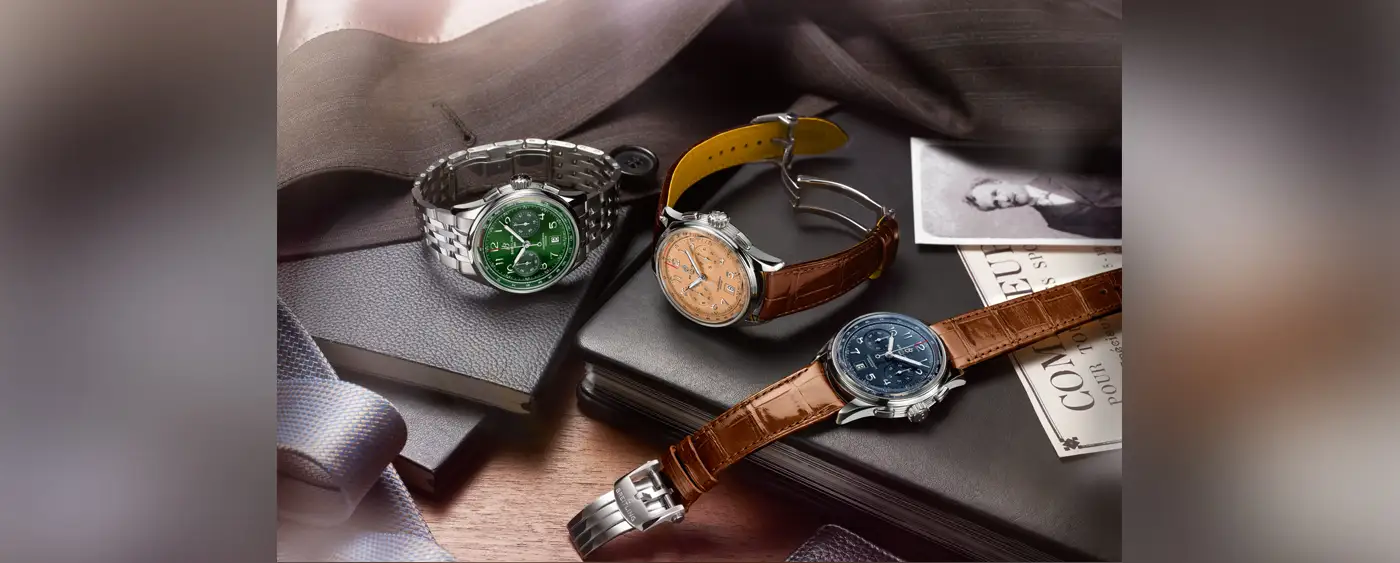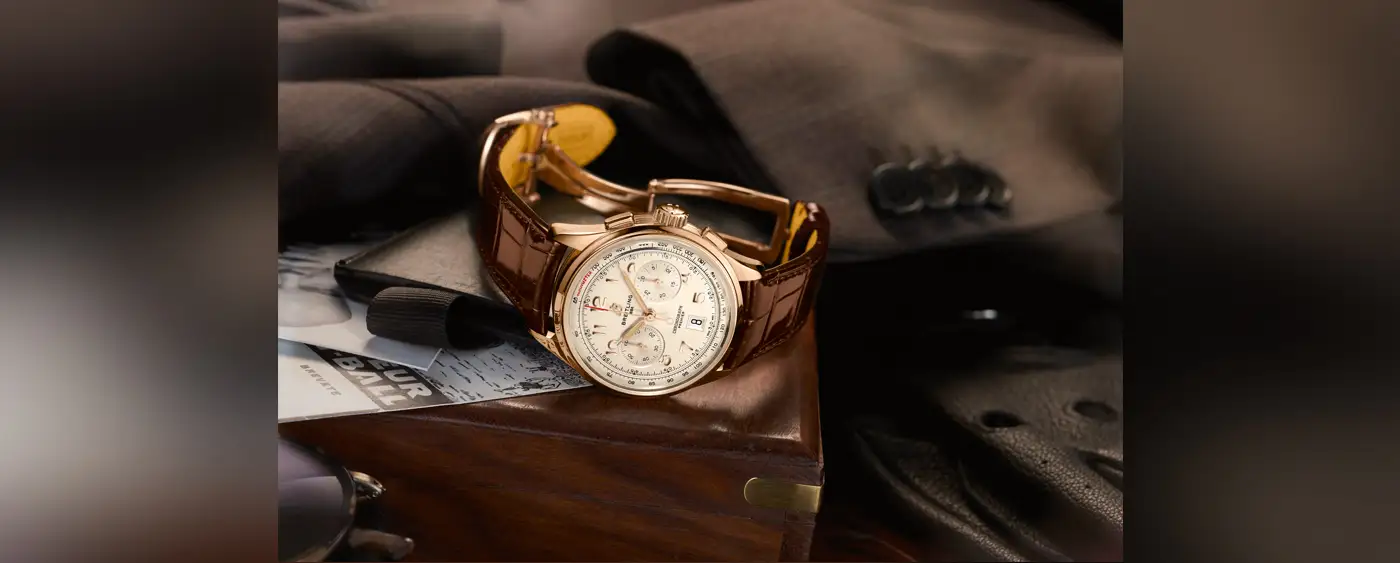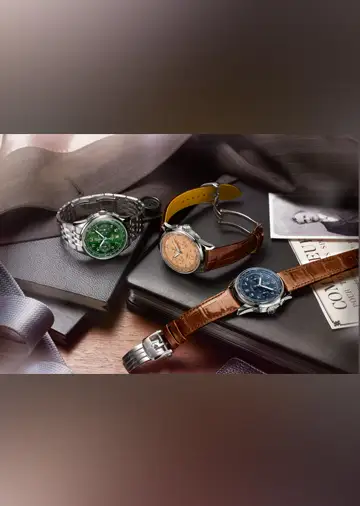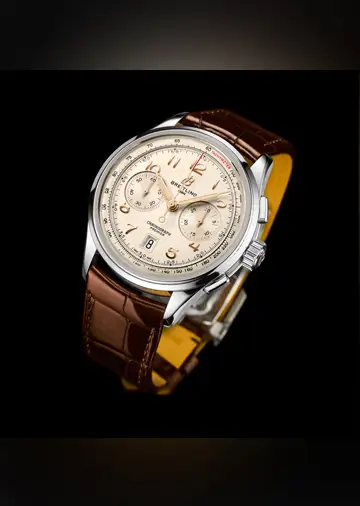
Always the First!
- Watches
- |
- 20 July 23
- Priya Kumari Rana
Breitling’s six model Premier line for 2023 and four Top Time models hark back to traditional watchmaking expertise coupled with a fresh innovations, colours, and detailing for the younger collector of today. Breitling’s Creative Director Sylvain Berneron speaks to us from Switzerland.
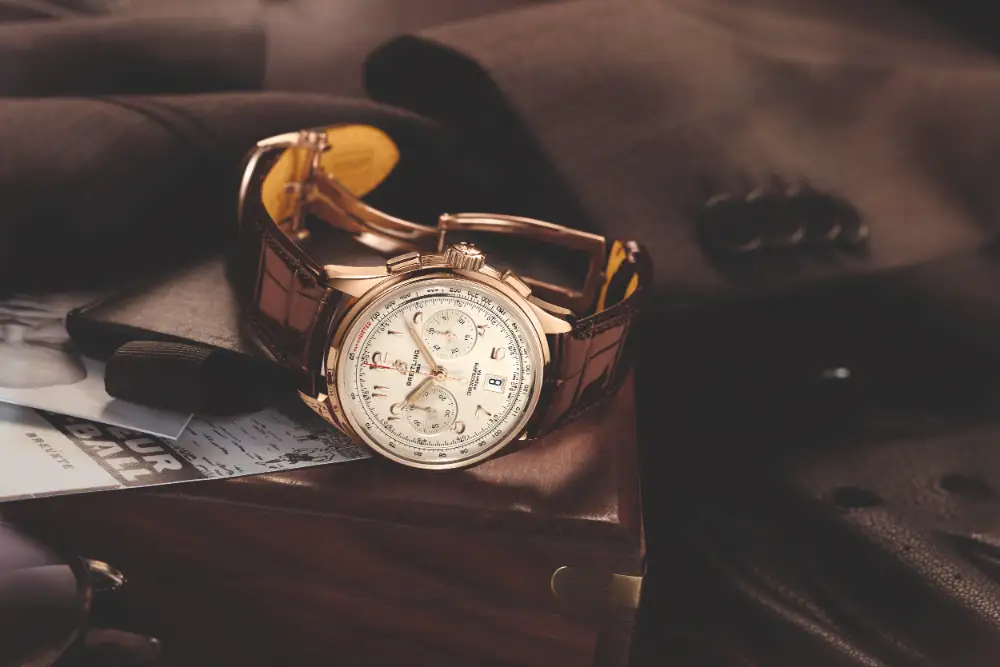 Premier B01 Chronograph 42 Ref. RB0145371G1P1
Premier B01 Chronograph 42 Ref. RB0145371G1P1
Ever since he created the very first pocket watch chronographs in Switzerland in 1884, Leon Breitling created his eponymous watch brand that has become one of the most redoubtable in the world, synonymous with indefatigable elegance, creating wristwatches that were purpose-driven, but stylish. In the 1940s, it was Leon's grandson Willy who thought of this idea of chronographs that were slick enough to be worn by the most dapper gentlemen in town – this was the genesis of the Premier line. Today, we've come full circle, with the brand looking back at its most covetable line, with a new, six model lineup, the 2023 Premier, 80 years after the first models were made, with the Breitling Manufacture Caliber 01. Breitling has also introduced four new Top Time 2023 models inspired by American muscle cars of the 60s and the 70s, all with the Breitling Manufacture Caliber 01 – a fresh take from their sold-out Top Time collection of 2021, with the addition of the fourth, eye-catching red-dial Ford Thunderbird model.
We speak to Sylvain Berneron, Creative Director, Breitling, about these stunning new collections, one that reflects the watchmaker's history of functional, but elegant watches, and the other, the sportier, more fun side of the maison, for a younger audience.
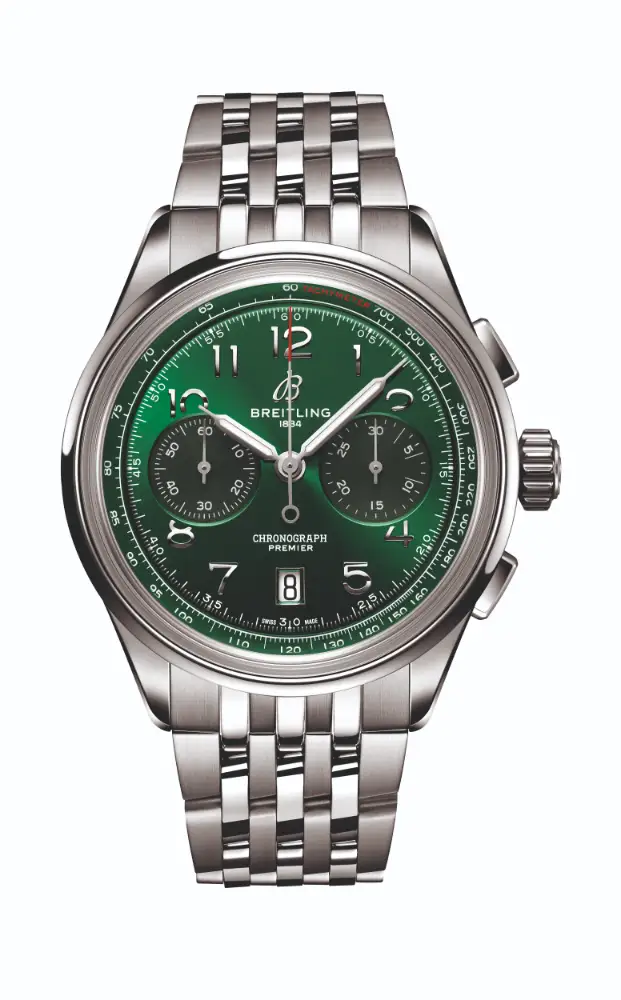 Breitling Premier B01 Chronograph 42 Ref. AB0145371L1A1
Breitling Premier B01 Chronograph 42 Ref. AB0145371L1A1
LI: Why has Breitling emphasized the Premier collection in its recent history?
Sylvain Berneron:
The line plays an important role in our portfolio and share a significant part of Breitling’s heritage. The Premier B01 is our flagship elegant watch series, whose roots can be traced back to the early 1940s, when Willy was looking forward to a post-World War II period where style and elegance could replace the austerity that defined watchmaking and fashion at that time. With the Premier, he introduced elegant chronographs that were resolutely stylish and beautifully made. The Premier B01 has been updated and refined for a new generation of discerning watch owners. It is a showcase both for our distinctive designs and our watchmaking expertise. As has always been the case, the Premier collection’s name speaks to its uncompromising quality.
That is the main reason why we decided to revive the Premier collection and emphasize Breitling’s watchmaking competences in the first place.
LI: The Premier collection, what was its genesis?
SB: The first Premier models were more of a gentleman's piece; the wearer was a businessman – there were tachymeters, decimal scales, telemeters built into them. These were first and foremost tools for businessmen to get their factories running, to get the quantities measured, it was the only way to get that information back then, and the tools were packaged in a very dressy manner. So the watches' stylish aspect is probably more impactful in the factory scenario, because these tools were worn by people wearing suits, and running factories, and multiple businesses. So that's the ground scenario on how this type of product emerged.
Over time, their relevance in terms of utility became less and less; rather, they became collectibles, deeply sought after by collectors, until the point where they became style accessories.
Now, we have revived the Premier collection, and even though we don't really need or use the chronograph, tachymeter, or decimal scale, they are deeply rooted in Breitling's heritage, which we want to keep alive. To keep the pieces relevant, we added a layer of technical complications. So in comparison, if you take a vintage Premier from the 40s, these pieces were not water resistant at all. I'm not sure you could even wash your hands wearing one! They had manual movements, so you had to wind them every morning. The precision was not to the standard you have today – these were the early days of the chronograph, so what we did in the Premier collection is make it 10 ATM, so it's 100 m water resistant; it has curved spring bars on the bracelet, to make the watch tighter and make it sit more on the wrist. We also added an automatic movement with a date wheel (you now have the date), so you don't have to wind the watch anymore, and these three things make the product more user friendly, and more comfortable to wear and live with, because you don't have to worry so much about it.
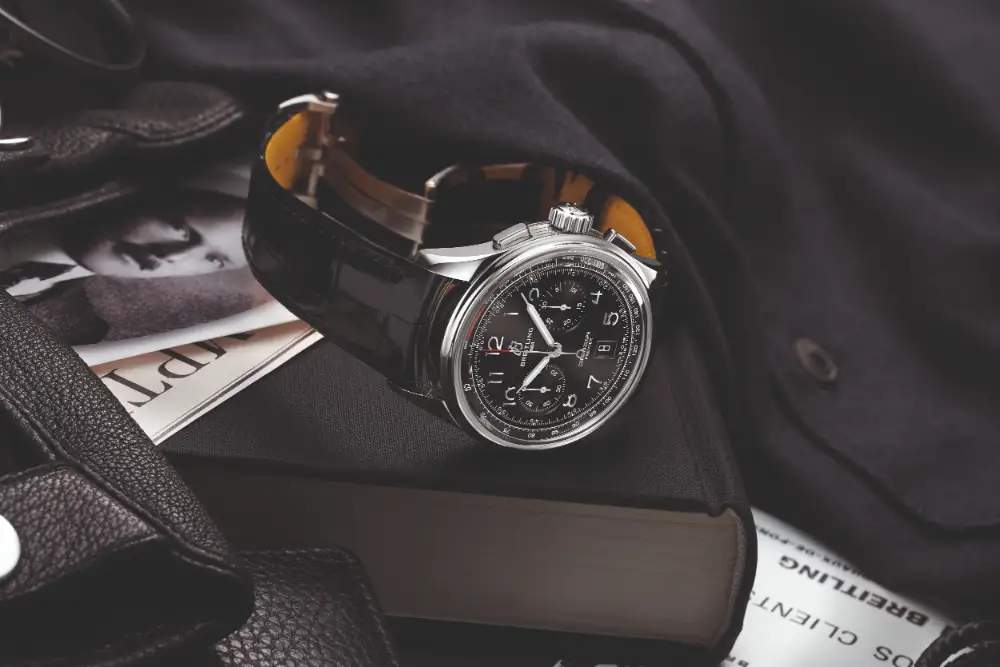 Breitling Premier B01 Chronograph Ref. AB0145221B1P1
Breitling Premier B01 Chronograph Ref. AB0145221B1P1
LI: Were some of the original pieces made of solid gold? Which is one of the most desired Premier?
SB: Breitling did a lot of solid gold cases in multiple movements, so you had chronographs, rattrapantes, complete calendars, and endless variations on different calibers. At that time the industry was very different, the watchmakers tended to use the movement they were producing, share cases or hands, use movements from the factory next door – very different from today's scenario, where every brand has to come up with its own movement and DNA.
But to answer your question, the most sought-after Premier is the Duograph, a manual-wind rattrapante movement in steel, and we produced only 25 pieces.
LI: Was the Premier Ref. 777 meant for doctors?
SB: Yes, we had different pieces for different jobs back then. In this case the 777 has a tachymeter on the dial, for frequencies, speeds, and distances. Usually the ones we produced for doctors were the ones with a pulsometer or pulsation scale on the dial, to measure the patient's heart rate, using your watch.
The tachymeter was also for pilots – where you could calculate, distances, timing, and a decimal scale for industrial production, that measured frequencies, in a factory. You could calculate how many pieces you would produce in one day, based on the rate it takes to produce one.
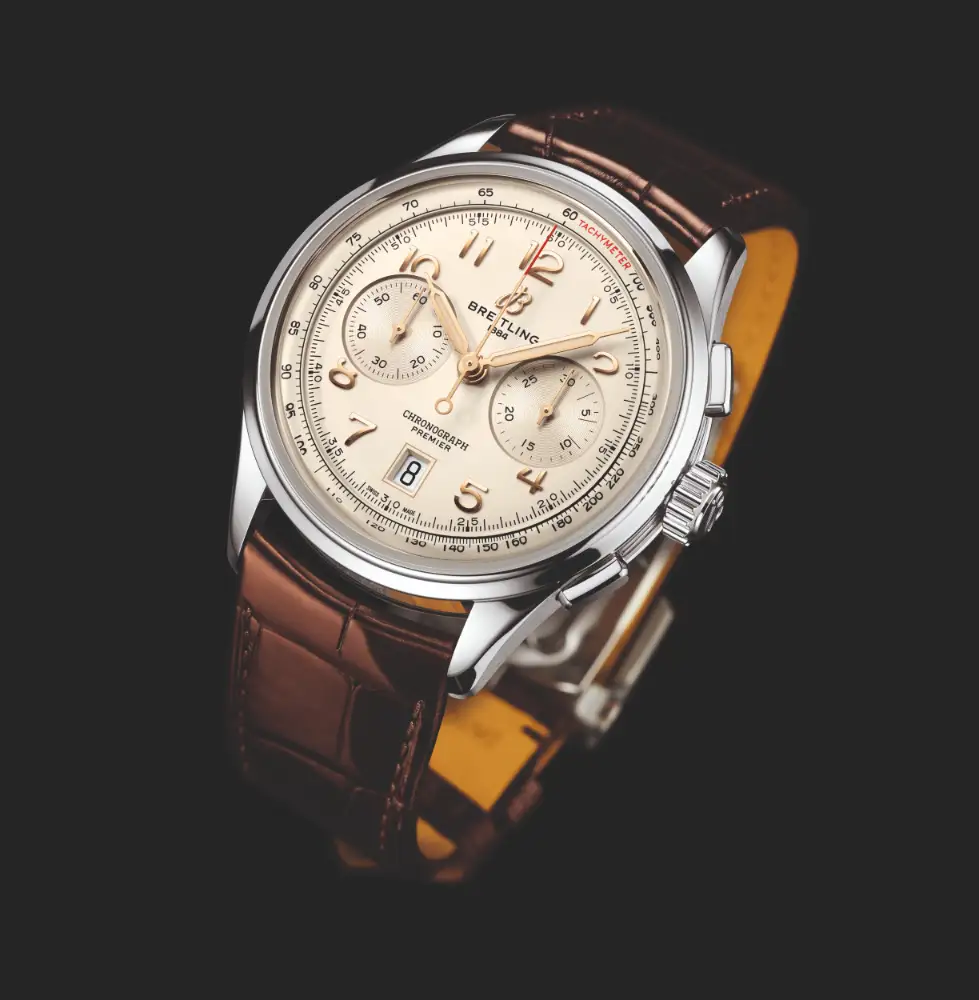 Breitling Premier B01 Chronograph 42 Ref. AB0145211G1P1
Breitling Premier B01 Chronograph 42 Ref. AB0145211G1P1
LI: Is the Duograph your version of the rattrapante?
SB: Yes, historically speaking, Breitling tends to use proprietary names for different complications. So for example, a complete calendar at Breitling was called a Datora, a rattrapante was a Duograph (manual and automatic).
LI: In the six new Premier models – what are the heritage components?
SB: First, if you look at the architecture of the dial, you have this tone on tone subdials of the chronographs. We also use Arabic numbers with the tachymeter. The piece is very loyal to the roots of the brand, in terms of how the dial is displayed. Overall, we are loyal to the heritage of the brand, as you can still buy a traditionally made chronograph for gentlemen. This is the heritage and legacy we wanted to maintain for the brand. And the most recognizable factor is the aesthetic of the watch, where you can tell that this is the little sister of the first models we made in the 40s and 50s.
LI: And what is the collection's departure from Premier line of 2021?
SB: Mainly, it's the technical improvements that changed the design. There's an increased water resistance, so we changed the proportion of the case. So you now have a screw-down case back – earlier you had a snap-down case back, far from ideal for dust and water – plus there's an open case back as well to display the manufacture B01 movement, which is probably the most amazing modern chronographs on the market – it's a vertical-clutch column-wheel integrated chronograph, so it's not a modular chronograph; this one has been built from scratch.
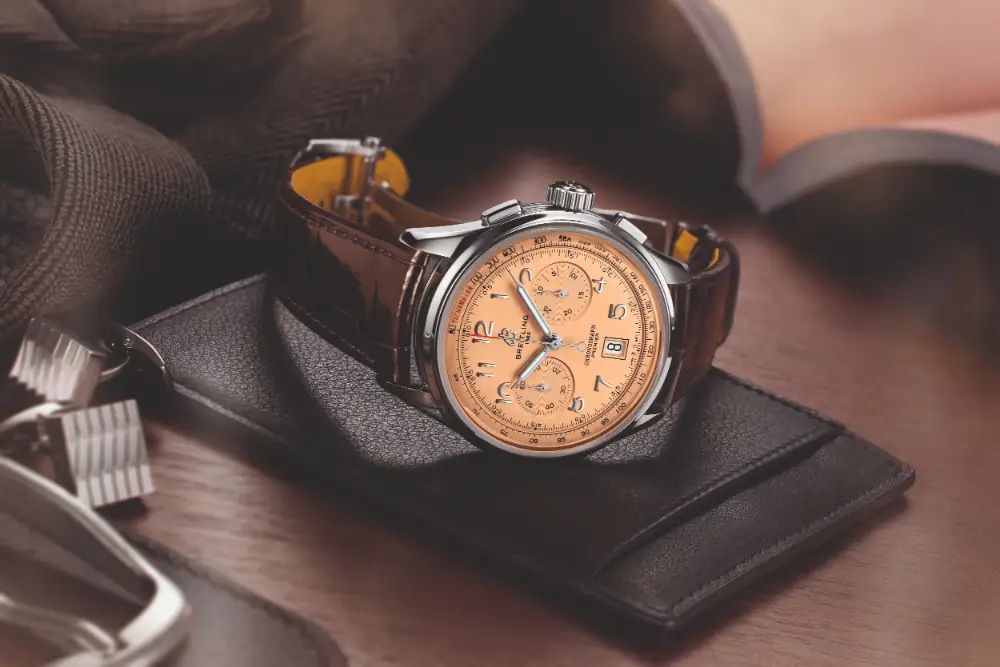 Breitling Premier B01 Chronograph 42 Ref. AB0145331K1P1
Breitling Premier B01 Chronograph 42 Ref. AB0145331K1P1
LI: Are the new models from the Premier line thinner than those of 2021?
SB: These six new pieces have an automatic caliber, and we had to have a rotor, so they are actually a bit thicker. The previous ones were hand-wound, but in today's market the manual caliber is harder to sell. You need to speak to a clientele that is more educated, more used to interact with watches, and such pieces are more demanding. You need to wind them, set them every couple of days, if you don't wear them every day. Manual calibers – whether it's a regular chronograph or a rattrapante – are dear to our heart at Breitling, because these are the fundamentals of traditional watchmaking, which is why we keep a few references in our portfolio, for the love of the discipline.
LI: There must have been feedback from customers to make the caliber 01 automatic?
SB: Yes, and to make the pieces more democratic, it's important for us to keep traditional watchmaking sexy and relevant for a younger audience, as they may not be bothered with winding theirs every day. So when you just entering the world of watchmaking, you want your timepiece to be waterproof, automatic, with a date wheel. You have bought it with your hard-earned money.
I fully understand that this product is targeting a younger watchmaking enthusiast, but once you do your journey as a collector, you tend to go back to simpler and purer things, So you have collectors that tend to wear smaller watches, which is why the manual wound model is 2 mm smaller. The automatic is 42 mm and the manual one goes back to 40 mm, it's slimmer, you lose the date, but it targets the more educated watch collector.
LI: When it comes to the colours of the dial – what were you inspired by?
SB: I would say the three dial colours are very historical – so you have the salmon, the black and the cream. These three colours are what you would find in the 40s and 50s, but in order to remain relevant and keep moving forward, and not remain in the past – and this is where it gets tricky – we introduced a green and blue dial, colours deeply appreciated by our customers since the last 5-10 years. So we get these two new flavours. If you prefer traditional dial colors, go for black, salmon, cream that are rooted in past. If you want a nice twist, go for the new colours – Breitling is a brave brand known for strong twists – just you look at the pistachio dial we offered in the Premier collection in 2021.
LI: Now for the new Top Time car collection – how does the design break convention?
SB: Top Time is a different recipe – it was born almost 20 years later in the 60s, at a time when the Breitling family wanted to target a younger audience. Our goal was to democratize the chronometer, in a new lifestyle of people doing sports and trips. This is how the Top Time was born, today we target a younger audience than for the Premier collection. Our goal is to have pieces that are irreverent, not so serious, playful.
The design of the case is architectural, simpler. The design of the dial has a much stronger graphic signature, and we try to play with a traditional layout, so the counters are no longer round, they have a TV-shaped-box-look. You would find large areas of colour on the dial, and that is how you keep Top Time's irreverent mindset. So these pieces are usually more accessible in terms of pricing; they have less attributes, but nonetheless they are pieces that are more modern, so that you can wear them more for more occasions, that is why Top Time and Premier complement one another.
LI: You have the new Ford Thunderbird model as well...
SB: The Top Time was initially launched in the US, hence we decided to have this link with muscle cars – which happened to be created in that decade; it's a good old revival of that era, to pay tribute to it. Even 50 years down the line, these cars are loved by car enthusiasts, which makes me think they found the sweet spots. I often get asked, why don't you do a line with modern cars, which have offer low CO2 emissions, and are high on safety – which are good things, but in terms of emotions, not as much. Also, the muscle cars are more fun.
Top Time is more emotional, graphic, intense, while Premier is more classic, reserved, composed.
LI: You played with red and black colours in the Corvette model...
SB: It's one of the most standout pieces... initially the Corvette C1 was red, so that is how we got the inspiration, and we really like the idea of a red dial in a Top Time collection, and if one collection can pull it off it's Top Time, in a dressier manner. We spent a lot of energy to define the right colour, so it has a nice reflection. Red is hard to play with. If you go too orange, it looks too sporty, and if it's too dark it looks like blood. So we hit a warm red that is not too burgundy and not too sporty.
LI: Do you put the colour in layers?
SB: Top Time dials are built in two plates. The counters are on the bottom plate, and on top, we add a second layer where we have translucent lacquer paint, so you can see the texture and brushing of the dial below the surface, as well as the colour and shine. These dials are complex to make, but we are very pleased with the result.
In the Ford Thunderbird model – we put forth a new colour variation, that goes into monochrome. We wanted to experiment and attempted to bring Top Time into a sharper take and better visual appeal. It sets itself apart.
LI: What about the latest Breitling squad?
SB: I don't think we have a dedicated squad every time per se. It's less and less about being endorsed by big names, it's for younger people, so they can enjoy hobbies – surfing, motorcycle, cars, and maintaining them.
LI: Which one of the Top Times will be one for the collectors?
SF: It's difficult – I'm a watch enthusiast – but I do like the blue dial Shelby, and the Ford Thunderbird as it's the freshest, with its tone on tone dial.
FOLLOW US ON INSTAGRAM

Lifestyle Insider is a kind of junction point, connecting people with diverse interests that touch on the more luxurious aspects of lifestyle – fashion, design, travel, food and spirits, art, watches and jewellery, cars, yachts, and aviation, and technology. People today don’t fit into boxes and categories. In our individual ways, we are interested in diverse themes, products, and the challenges that face our world today. You will judge how well this effort of mine caters to your passions and proclivities.
Lifestyle Insider is a showcase of all that is beautiful and luxe. Behind every creation, is a designer, chef, entrepreneur, or a design maison. I have delved into my own appreciation for objetsde luxe that I have admired over the years – be it a love of fashion from the world’s top Parisian and Italian fashion maisons and their ’90s muses, or the care that goes into sari and Indian textile collections in my own family. Growing up on four continents, as the daughter of a former Indian Ambassador, I’ve seen a remarkable array of historic places and met a myriad people. My aim is to bring my world view into this website, a curation of what I find particularly stunning, unique, and newsworthy.
It’s an exciting time for brands all over the world. With change comes opportunity. With the global ‘reset’ and uncertainty on many fronts, there is a chance to write a new script. Let’s be those pioneers.
A bit about me:
A luxury and fashion journalist with 25 years of experience in publishing and magazine journalism, I have edited some of India’s top fashion and luxury magazines. I got my BA in Comparative Literature from UC Berkeley, and went on to receive my Master’s in English and French from the University of Strasbourg, France. I have also studied German and Film. I live in Gurugram, India, and look forward to once again exploring our world with a new-found freedom.
Priya Kumari Rana
Founder and EditorContact Us
Mail us @ lifestyleinsiderindia@gmail.com
